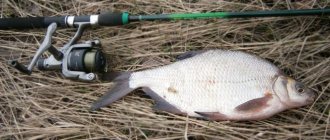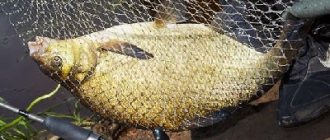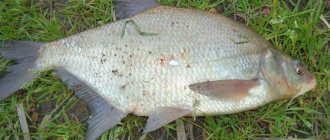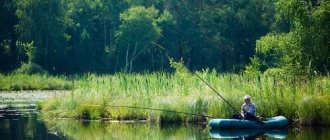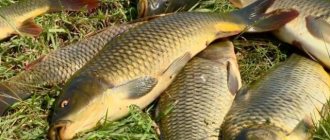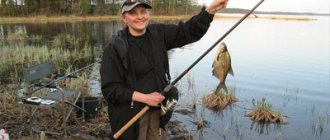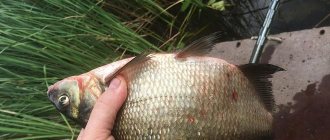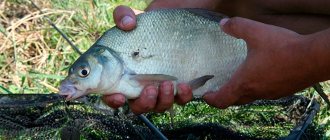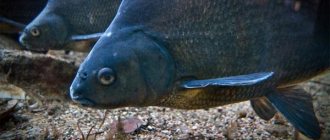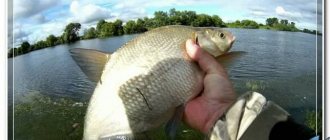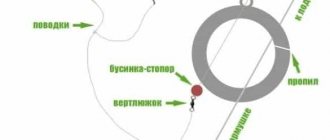What kind of fish is this
Black bream is a peaceful underwater inhabitant, a representative of the bream genus (Abramis). Their external feature is a flat, wide body, flattened laterally. Its height is on average one third of the length of the fish. Outwardly, it is similar to ordinary bream and other related species.
The head is small, the eyes are small with black irises, the mouth is directed upward. The back behind the back of the head rises sharply in an arc. It has a high fin consisting of nine soft rays. The paired pelvic and pectoral fins are medium in size, followed by an elongated anal keel.
The body of the fish is covered with small scales. The back color is black. The sides are dark, the belly of the fish is lighter than other parts of the body. The fins have a pronounced dark color, which can vary depending on the specific section of the river or lake where the individual lives.
Juvenile black Amur bream are noticeably lighter than their older brothers.
This representative of the ichthyofauna grows quickly. Under favorable conditions and a full food supply, the fish can grow up to 3 kg with a body length of 55–60 cm. There is information about the capture of specimens weighing about 4 kg. The average size of individuals found in catches is 1–1.5 kg.
Amur black bream is found from the Amur basin in the north and the Pearl River in Guangdong province in the south. In Russia, it inhabits sections of the Amur from Blagoveshchensk to Bolon, it was recorded in the area of the settlement of Novo-Ilyinovka, and is found in the bed of the Ussuri River and Lake Khanka.
Since 2015, ichthyologists and fishermen began to record cases of catching Amur bream in the basin of the Ile River, which flows through the territory of Kazakhstan. This is due to the cross-border migration of sexually mature individuals from the Chinese Amur to the upper reaches.
We recommend reading: How to catch crucian carp in the spring on a feeder
Black Amur bream (Megalobrama mantschuricus (Basilewsky, 1855))
Large fish: reaches a length of 60 cm and a weight of 4.3 kg. Life expectancy is at least 10 years. This is what ichthyologists of the 21st century think. Nevertheless, at the end of the 19th century, bream weighing up to 6 kg were caught in the Amur, and up to 5 kg in Ussuri. Record holders of the 20th century were also noted.
M. L. Krykhtin writes: the record holder of our days is a specimen of black bream caught on May 9, 1956 in the Siy channel. Remember: length 78 centimeters, weight 7600, age 17 years.
S. P. Kucherenko, 2005
Black Amur bream [2]
I would like to note on my own that we have more than once caught black Amur bream weighing from 1.6 to 2.74 kg on the Shargol channel. They are caught in single specimens, usually when catching carp on bread or canned corn. It is impossible to convey all the emotions when catching this amazing fish and it is a pity to part with it, but... be that as it may, we have to release the Red Book bream.
Being very rare in the Amur, black bream is not of significant importance as a fishery object. It is caught mainly by cast seines when catching other fish. In terms of its commercial qualities, it is much higher than white bream.
G. V. Nikolsky, 1956
What does black Amur bream look like?
The back is black. The sides and belly are also dark, but still slightly lighter than the back. The fins are almost black, it even seems to me that they are darker than those of the Chinese bream. Even the iris is dark, as if made of blued silver. The head and mouth of black bream are small. What else would they look like with his tall body?! By the way, when photographing fish on the shore, it is not always possible to get a photo that is 100% similar to the original.
Distribution area
The range covers the basins of the Amur, Yellow and Yangtze rivers, as well as the reservoirs of the Yellow Sea coast. In the Khabarovsk Territory, black Amur bream is found in all municipal districts located along the Ussuri and Amur rivers: from Bikinsky in the south to Komsomolsky in the north. Occasionally found further down the Amur River. Lives in the Primorsky Territory (Ussuri River and Lake Khanka) and in the Jewish Autonomous Region (in the Amur section from Khabarovsk to the Sungari River).
Where does the black Amur bream live and what does it eat?
In summer it lives in the Amur riverbed, in large channels, and also in floodplain reservoirs. In autumn it leaves lakes and streams for the winter. Due to the fact that it is rare in the Amur basin, it is still not sufficiently studied.
Black Amur bream is euryphagous, that is, omnivorous. Mollusks occupy a significant place in its diet, but it also feeds on filamentous algae, higher aquatic vegetation, crustaceans, insect larvae, and even small fish.
When and where does it spawn?
Black Amur bream grows slowly and takes a long time to mature. Moreover, females become adults at the age of 7 years with a length of 37 cm, and males at the age of 6 years with a length of 32 cm. They become decrepit from a decade and a half, reaching 60 cm in length and about 4 kg of weight.
Spawning in June-July at water temperatures of 19–26 °C. Bottom caviar is spawned in two portions. The main spawning grounds are located between the city of Khabarovsk and the lake. Bologne. Fertility up to 470 thousand eggs. However, there is another opinion on this matter.
It matures in the sixth year of life, reaching a length of about 30 cm. The eggs are laid on the bottom and vegetation. Fertility - about 250 thousand eggs.
G. V. Novomodny, 2014
How to distinguish black bream from white
The easiest way to distinguish black from white bream is by color, although for a novice fisherman these differences may seem insignificant. Black bream (both body and fins) is in any case darker than white. The main difference is that the scaleless keel of the black bream is behind the pelvic fins, while that of the white bream stretches across the entire abdomen. In addition, black bream have a noticeable hump in front of the dorsal fin. Perhaps the last difference is more noticeable at first glance than the others.
Why black Amur bream is included in the Red Book
In the Amur, black bream is generally found much less frequently than white bream, and this has always been the case. Black Amur bream was included in the Red Book of Russia on the recommendation of M. L. Krykhtin in the status of “first category” as an endangered species. Moreover, due to a “steady decline in numbers” in the 70-80s, the species was included in the Red Books of all levels.
It is protected by the rules of fishing for freshwater fish on the Amur, as well as by the Russian-Chinese rules of fishing in the border waters of the Amur and Ussuri rivers. Special measures to protect black bream in the Russian waters of the Amur will not be required in the next decade.
Red Book of Khabarovsk Territory
I can’t resist the temptation to give another quote.
No special conservation measures are currently required for this species. An annual ban on fishing for small fish in the Amur during the spawning period is sufficient to maintain the number of this species necessary for the ecosystem. There is currently no threat of extinction of this species in the Amur. This is a phytophilic species, so it is necessary to ensure that hydroelectric power plants located in the Amur basin comply with the natural flood regime. It would be advisable to remove it from the Red Book or transfer it to the fifth category (according to the IUCN classification).
G. Novomodny, S. Zolotukhin, P. Sharov, 2004
Lifestyle
Black bream is a bottom dweller. Leads a predominantly sedentary lifestyle. Seasonal migrations are observed only during the pre-spawning period. The rest of the time, the fish takes their usual places:
- channel areas;
- holes, ditches, ravines;
- sharp coastal edges and slopes.
It loves a hard sandy bottom and is found in areas strewn with shells, pebbles, and small stones. The fish prefers to stay in the current; it tries to avoid stagnant places with muddy soil and abundant aquatic vegetation.
In the summer, the fish fattens up, eats up, and gains weight. At night, it rises to the surface and approaches spits and shallows. With colder weather, it concentrates on channel holes, gathering into dense schools, which consist of individuals of approximately the same size.
In winter it grows on holes, dumps, long ditches and ravines. In cold weather it stands at the bottom, moves little, and rarely feeds. During a thaw, it can rise to the middle horizon, enter branches, oxbow lakes, backwaters and other branches from the main river bed.
Amur bream is a schooling representative of the ichthyofauna. In one school there are kept individuals of predominantly the same weight and age. Juveniles gather in numerous clusters, medium and large specimens “hang out” in limited groups. Sometimes in a small area there are fish of different sizes.
The average life expectancy of this representative of the ichthyofauna is 10 years.
Reaches sexual maturity in the sixth year of life. At this age, the size of the fish is 30–35 cm with a body weight of about 1–1.2 kg. Spawns annually in June - first half of July. To do this, it goes upstream, choosing areas with calm water and average depths. The fertility of an adult female is 250 thousand eggs. Pelagic caviar.
Black Amur bream is a peaceful fish. His diet consists of:
- benthic invertebrates;
- shellfish;
- phyto and zooplankton;
- insect larvae and pupae;
- crustaceans.
Recommended reading: How to catch bream on the river in winter
Large individuals can attack small fish. In conditions of poor food supply, they eat filamentous algae.
White bream
Description
White bream belongs to the smaller varieties of common bream and reaches a maximum body length of 35-40 cm, weighing up to 4 kg. The general color of the fish is light. In particular, the back has brownish or gray-greenish tints, the rest of the body is silvery. There is a scaleless keel on the belly. The dorsal and caudal fins are dark, the paired fins are lighter. The small head is equipped with a small, slightly protruding mouth with hard lips. Prefers plant foods. Puberty occurs at 6 years of age. Prefers to stay in packs. White bream meat has excellent taste. The fish is used as an object for artificial breeding.
Habitats
The natural habitat is the area of the Amur River from the estuary to the mouth of the Kumari River, as well as the Ussuri River, Lake Sungari and Khanka. At the moment, this fish is also found in the basins of the Syrdarya and Amu Darya rivers, where it was introduced artificially. It prefers to live in deep places with a slight current, a muddy bottom with fairly dense vegetation.
Time and characteristics of fishing
Fishing for white bream begins at the beginning of summer and continues throughout the warm period of the year. As usual, it comes closer to the shore to feed. In clear, calm, but not hot weather, the bite occurs in the morning and evening hours. A float rod is used as tackle. Large bait is not immediately available, so hooking is often necessary.
What do they bite on?
Targeted fishing for black bream is prohibited. The fish is protected by law as a rare endangered species. However, you need to know what this underwater resident bites on in order to take his preferences into account when going fishing for other fish.
Caught by an earthworm, it likes to feast on a bunch of bloodworms or a pair of maggots attached to a hook with a short shank. It can take the larva of a semi-aquatic insect for the meat of a mollusk separated from the shell. Of the plant baits you come across:
- parboiled wheat;
- mastyrka;
- canned corn.
Active in cool and warm water. Caught when fishing with bottom and feeder gear for carp, horse, burbot, chebak and other bottom fish.
Other baits
A separate type of bream bait are boilies on a hair rig. This bait should measure 8-12 mm. If the size is smaller, small fish may bite. In this case, both bottom and float tackle are used.
You can buy boilies, but you can also prepare them at home. The recipe is simple. You need to take 100 g of ground seeds, 10 g of sugar, 10 g of flour and 30 g of egg powder. Knead this into a thick dough, stand, roll into balls, boil, and then dry. The finished bait is placed in a plastic bag with the addition of a small amount of ground flour and placed in the refrigerator.
Experienced bream fishermen recommend using combinations or “sandwiches” as bait:
- pearl barley and maggots;
- corn and worm;
- worms and maggots;
- bloodworms and worms (sometimes dough is added);
- bloodworms and maggots.
Such combinations are very effective when fishing.
Conservation status
Black Amur bream is an endangered species whose numbers are steadily declining. This is due to the following factors:
- its intensive fishing in the main Amur spawning grounds by Chinese commercial fishermen;
- reduction of spawning areas;
- lowering the water level in the Amur;
- water pollution.
In the Russian part of the Amur, its fishing has been prohibited since 1981. The species is included in the Red Book of Russia and is protected in state nature reserves and reserves: Bologna, Komsomolsky, Khankansky. Fish needs protection and artificial reproduction.

